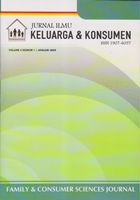HUBUNGAN ANTARA FUNGSI ADAPTASI, PENCAPAIAN TUJUAN, INTEGRASI, DAN PEMELIHARAAN SISTEM DENGAN KESEJAHTERAAN KELUARGA
Abstract
AGIL (Adaptation, Goal attainment, Integration, and Latency) is refers to the functions that indicate a system capability of the to sustain. In this research, a system refers to a family system. The objective of this study is to analyze the correlation among research’s variables i.e., family social economic characteristics, AGIL family functions and family welfare. The research design was a cross sectional study and involved 120 samples that chosen from this research’s sampling frame. Result of research showed that there were positive significant correlation between: (i) adaptation with goal attainment, (ii) goal attainment with integration, and (iii) integration with latency. Those mean that the more adaptation being done, the more aims that the family want to achieve; then the more and the better integration and latency in functions of the family. Beside that, there were also positive significant correlation among adaptation, goal attainment and objective welfare. Those mean that the more adaptation function being done and the more aims that family want to achieve; then the higher the family objective welfare. Latency function of family had a positive correlation with subjective welfare. It means that the better latency in poor farmer families lead the higher the family subjective welfare.
Authors submitting manuscripts should understand and agree that copyright of manuscripts published are held Jurnal Ilmu Keluarga dan Konsumen. The statement to release the copyright to Jurnal Ilmu Keluarga dan Konsumen is stated in Copyright Release Form. Copyright encompass exclusive rights to reproduce, to distribute, and to sell any part of the journal articles in all form and media. The reproduction of any part of this journal is allowed with a written permission from Jurnal Ilmu Keluarga dan Konsumen.









